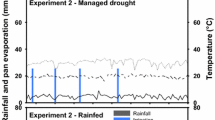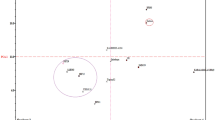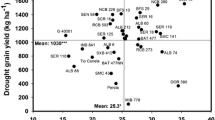Abstract
Identifying combined abiotic (waterlogging) and biotic (Pythium) stress resistance is critical if common bean (Phaseolus vulgaris) productivity in disease-prone regions with irregular but intensive rainfall patterns is to be productive. In this study, 194 common bean varieties from 37 countries were screened, documenting the effects of waterlogging on damping-off, as well as hypocotyl and root disease severity caused by Pythium irregulare. Varieties Quqa lecherita [Percent Hypocotyl Disease Index (%HDI) 33.3, Percent Root Disease Index (%RDI) 37.5] and PAC 18 (%HDI = 40.0, %RDI = 49.9) showed the greatest resistance to Pythium. Variety RIZ 102 showed the most tolerance to waterlogging with the mean tolerance value 3.6. Navy Veracruz (%HDI unwaterlogged 50.0, waterlogged 30.0; %RDI unwaterlogged 68.8, waterlogged 45.8), Negro argel (%HDI unwaterlogged 47.5, waterlogged 45.0; %RDI unwaterlogged 56.3, waterlogged 43.8), and Phavul 77 (%HDI unwaterlogged 50.0, waterlogged 43.3; %RDI unwaterlogged 56.3, waterlogged 41.7) had combined resistance to P. irregulare and tolerance to waterlogging. This is the first study to identify combined abiotic and biotic stress resistances in common bean. There were significant correlations between hypocotyl disease severity (without waterlogging) with country of origin, with days to flowering, and with seed lustre, highlighting promising foci in developing improved bean varieties. The results demonstrated that there is ample genetic variation in common bean that can be exploited to combine root/hypocotyl disease resistance and waterlogging tolerance into new cultivars to suit a variety of environments challenged by both root/hypocotyl disease and periodic waterlogging.


Similar content being viewed by others
References
Abawi, G. S., & Widmer, T. L. (2000). Impact of soil health management practices on soilborne pathogens, nematodes and root diseases of vegetable crops. Applied Soil Ecology, 15, 37–47.
Abawi, G. S., Ludwig, J. W., & Gugino, B. K. (2006). Bean root rot evaluation protocols currently used in New York. Annual Report of Bean Improvement Cooperative, 49, 83–84.
Acosta-Gallegos, J.A. (1988). Selection of common bean. PhD dissertation. Michigan State University, East Lansing.
Allmoras, R., Kraft, J. M., & Miller, D. E. (1988). Effects of soil compaction and incorporated crop residue on root health. Annual Review of Phytopathology, 26, 219–243.
Asensio-S.-Manzanera, M. C., Asensio, C., & Singh, S. P. (2006). Gamete selection for resistance to common and halo bacterial blights in dry bean intergene pool populations. Crop Science, 46, 131–135.
Barbetti, M. J., & MacNish, G. C. (1978). Root rot of subterranean clover in the irrigation areas of south-western Western Australia. Australian Journal of Experimental Agriculture and Animal Husbandry, 18, 426–433.
Barbetti, M. J., Riley, I. T., You, M. P., Li, H., & Sivasithamparam, K. (2006). The association of necrotrophic fungal pathogens and plant parasitic nematodes with the loss of productivity of annual medic-based pastures in Australia and options for their management. Australasian Plant Pathology, 35, 691–706.
Barbetti, M. J., You, M. P., Li, H., Ma, X. L., & Sivasithamparam, K. (2007). Management of root diseases of annual pasture legumes in Mediterranean ecosystems – a case study of subterranean clover root diseases in the south-west of Western Australia. Phytopathologia Mediterranea, 46, 239–258.
Baudoin, J. P., Camarena, F., Lobo, M., & Mergeai, G. (2001). Breeding Phaseolus for intercrop combinations in Andean highlands. In H. D. Cooper, C. Spillane, & T. Hodgkin (Eds.), Broadening the genetic base of crop production (pp. 373–384). Oxford: CABI Publishing.
Beebe, S., Rao, I., Blair, M.W., & Butare, L., (2009). Breeding for abiotic stress tolerance in common bean: present and future challenges. The SABRAO Journal of Breeding and Genetics, 41: special supplement.
Beninger, C. W., Hosfield, G. L., Bassett, M. J., & Owens, S. (2000). Chemical and morphological expression of the B and Asp seedcoat genes in Phaseolus vulgaris. Journal of the American Society for Horticultural Science, 125, 52–58.
Brown, M. B., & Forsythe, A. B. (1974). Robust tests for equality of variances. Journals of the American Statistical Association, 69, 364–367.
Brown, G. E., & Kennedy, B. W. (1966). Effect of oxygen concentration on Pythium seed rot of soybean. Phytopathology, 56, 407–411.
Bruno, L., & Griffiths, P. D. (2004). Evaluation of common bean accessions for resistance to Pythium ultimum. Hortscience, 39, 1193–1195.
Chatel, D., & Francis, C. (1975). Sources of variation in the resistance of subterranean clover to clover scorch (Kabatiella caulivora) in the field. Austrlian Journal of Experimental Agriculture, 15, 541–544.
CIAT. (1997). Looking upward to grow more beans. Colombia: Centro Internacional de Agricultura Tropical (CIAT). News Release. http://www.ciat.cgiar.org/comunic/news11.html.
Draffehn, A. M., Li, L., Krezdorn, N., Ding, J., Lübeck, J., Strahwald, J., Muktar, M. S., Walkemeier, B., Rotter, B., & Gebhardt, C. (2013). Comparative transcript profiling by SuperSAGE identifies novel candidate genes for controlling potato quantitative resistance to late blight not compromised by late maturity. Frontiers in Plant Science, 4, article number 423. http://www.frontiersin.org/Journal/Abstract.aspx?s=905&name=plant_genetics_and_genomics&ART_DOI=10.3389/fpls.2013.00423. Accessed on 7th November, 2014.
Emam, Y., Shekoofa, A., Salehi, F., & Jalali, A. H. (2010). Water stress effects of two common bean cultivars with contrasting growth habits. American Eurasian Journal of Agricultural and Environmental Science, 9, 495–499.
Graham, P. H., & Ranalli, P. (1997). Common bean (Phaseolus vulgaris L.). Field Crops Research, 53, 131–146.
Green, H., & Jensen, D. F. (2000). Disease progression by active mycelial growth and biocontrol of Pythium ultimum var. ultimum studies using a rhizobox system. Phytopathology, 90, 1049–1055.
Harvey, P., (2004). Crop rotation could reduce Pythium root rot. Cropping Disease Management ahead, 2004, number 154. http://www.clw.csiro.au/publications/farming_ahead/2004/38,%2040%20FA%20NOV2004_154.pdf. Accessed on 7th November, 2014
Hendrix, F. F., Jr., & Campbell, W. A. (1973). Pythiums as plant pathogens. Annual Review of Phytopathology, 11, 77–98.
Hilllocks, R. J., Madata, C. S., Chirwa, R., Minja, E. M., & Msolla, S. (2006). Phaseolus bean improvement in Tanzania, 1959–2005. Euphytica, 150, 215–231.
Islam, F. M. A., Rengifo, J., Redden, R. J., Basford, K. E., & Beebe, S. E. (2003). Association between seed coat polyphenolics (tannins) and disease resistance in common bean. Plant Foods for Human Nutrition, 58, 285–297.
Jackson, M. B., & Colmer, T. D. (2005). Response and adaptation by plants to flooding stress. Annals of Botany, 96, 501–505.
Jackson, D. P., Enebak, S. A., & South, D. B. (2012). Effects of Pythium species and time in cold storage on the survival of bareroot and container-grown Southern pine seedlings. International Scholarly Research Network Ecology, 2012, 7.
Keane, P., & Brown, J. (1997). Disease management. In J. F. Brown & H. J. Ogle (Eds.), Plant pathogens and plant diseases (pp. 405–426). Armidale: University of New England.
Kerr, A. (1964). The influence of soil moisture on infection of peas by Pythium ultimum. Australian Journal of Biological Science, 17, 676–685.
Lakitan, B., Wolfe, D. W., & Zobel, R. W. (1992). Flooding affects snap bean yield and genotypic variation in leaf gas exchange and root growth response. Journal of American Society for Horticulture Science, 117, 711–716.
Li, Y. P., You, M. P., & Barbetti, M. J. (2014). Species of Pythium associated with seedling root and hypocotyl disease on common bean (Phaseolus vulgaris) in Western Australia. Plant Disease, 98, 1241–1247.
Li, Y.P., You, M.P., Colmer, T.D., & Barbetti, M.J., (2015). Effect of timing and duration of soil saturation on soilborne Pythium disease of common bean (Phaseolus vulgaris). Plant Disease, 99, 112–118.
Lima, E. R., Santiago, A. S., Araújo, A. P., & Teixeira, M. G. (2005). Effects of the size of sown seed on growth and yield of common bean cultivars of different seed sizes. Brazilian Journal of Plant Physiology, 17, 273–281.
Louise, L., & Paul, H. (2006). Rooting out Pythium and its allies. Farming Ahead, 177, 42–44.
Lucas, B., & Griffiths, P. D. (2004). Evaluation of common bean accessions for resistance to Pythium ultimum. Hortscience, 39, 1193–1195.
Mahuku, G. S., Jara, C., Cajiao, C., & Beebe, S. (2003). Sources of resistance to angular leaf spot (Phaeoisariopsis griseola) in common bean core collection, wild Phaseolus vulgaris and secondary gene pool. Euphytica, 130, 303–313.
McKinney, H. H. (1923). Influence of soil temperature and moisture on infection of wheat seedlings by Helminthosporium sativum. Journal of Agricultural Research, 26, 195–218.
Miklas, P. N., Kelly, J. D., Beebe, S. E., & Blair, M. W. (2006). Common bean breeding for resistance against biotic and abiotic stress: from classical to MAS breeding. Euphytica, 147, 105–131.
Nederhoff, E. (2000). Pythium only successful in stressed plants. Commercial Grower, 55, 41–42.
Nzungize, R. J., (2012). Identification of Pythium species inducing common bean (Phaseolus vulgaris L.) root rot symptoms and development of backcrosses to improve the level of varietal resistance to this disease (p. 119). PhD Thesis. Liege University Gembloux Agro-Bio Tech.
Nzungize, J. R., Lyumugabe, F., Busogoro, J.-P., & Baudoin, J.-P. (2012). Pythium root rot of common bean: biology and control methods. Biotechnology, Agronomy, Society and Environment, 16, 405–413.
Otsyula, R. M., & Ajanga, S. I., (1994). Control strategy for bean root rot in Western Kenya. Proceedings of the 4th KARI Scientific Conference (p. 22) Nairobi, Kenya.
Otsyula, R. M., Rubaihayo, P., & Buruchara, R. A. (2003). Inheritance of resistance to Pythium root rot in Beans (Phaseolus vulgaris) genotypes. African Crop Science Society, 6, 295–298.
Pachico, D. (1993). The demand for bean technology. In G. Henry (Ed.), Trends in CIAT commodities 1993 (pp. 60–74). Colombia: Centro Internaicional de Agricultura Tropical (CIAT).
Pieczarka, D. J., & Abawi, G. S. (1978). Influence of soil water potential and temperature on severity of Pythium root rot of snap beans. Phytopathology, 68, 766–772.
Rusuku, G., Buruchara, R. A., Gatabazi, M., Pastor-Carrales, M. A., & Schmitthenner, A. F. (1997). Effect of crop rotation on Pythium ultimum and other Pythium species in soil. Phytopathology, 52, 27.
Schmitthenner, A. F. (1970). Significance of populations of Pythium and Phytophthora. in soil. In R. A. Toussoun, R. V. Bega, & P. E. Nelson (Eds.), Root diseases and soil-borne pathogens (pp. 25–27). London: University of Califonia Press.
Statler, G. D. (1970). Resistance of bean plants to Fusarium solani f. phaseoli. Plant Disease Reporter, 54, 698–699.
Sun, S., Kim, M., Van, K., Lee, Y.-W., Li, B., & Lee, S.-H. (2013). QTLs for resistance to Phomopsis seed decay are associated with days to maturity in soybean (Glycine max). Theoretical and Appliled Genetics, 126, 2029–2038.
Visker, M. H. P. W., van Raaij, H. M. G., Keizer, L. C. P., Struik, P. C., & Colon, L. T. (2004). Correlation between late blight resistance and foliage maturity type in potato. Euphytica, 137, 311–323.
Wong, D. H., Barbetti, M. J., & Sivasithamparam, K. (1984). Effects of soil temperature and moisture on the pathogenicity of fungi associated with root rot of subterranean clover. Australian Journal of Agricultural Research, 35, 675–684.
Wortmann, C. S., Robin, B., & Eledu, C. (1998). Distribution of bean root rot in sub-Saharan Africa. Annual Report of the Bean Improvement Cooperative, 41, 212–213.
You, M. P., Barbetti, M. J., & Nichols, P. G. H. (2005). New sources of resistance identified in Trifolium subterraneum breeding lines and cultivars to root rot caused by Fusarium avenaceum and Pythium irregulare and their relationship to seedling survival. Australasian Plant Pathology, 34, 237–244.
Acknowledgments
The first author gratefully acknowledges the financial assistance of an International Postgraduate Research Scholarship. We appreciate the operational funding support for this research provided by the School of Plant Biology, The University of Western Australia. We are grateful to Dr Bob Redden, Australian Grains Genebank, Department of Primary Industries, Horsham, Victoria, Australia, for his assistance in locating and sourcing appropriate germplasm and his encouragement to locate new disease resistances in common bean.
Author information
Authors and Affiliations
Corresponding author
Rights and permissions
About this article
Cite this article
Li, Y.P., You, M.P., Norton, S. et al. Resistance to Pythium irregulare root and hypocotyl disease in diverse common bean (Phaseolus vulgaris) varieties from 37 countries and relationships to waterlogging tolerance and other plant and seed traits. Eur J Plant Pathol 146, 147–176 (2016). https://doi.org/10.1007/s10658-016-0901-2
Accepted:
Published:
Issue Date:
DOI: https://doi.org/10.1007/s10658-016-0901-2




